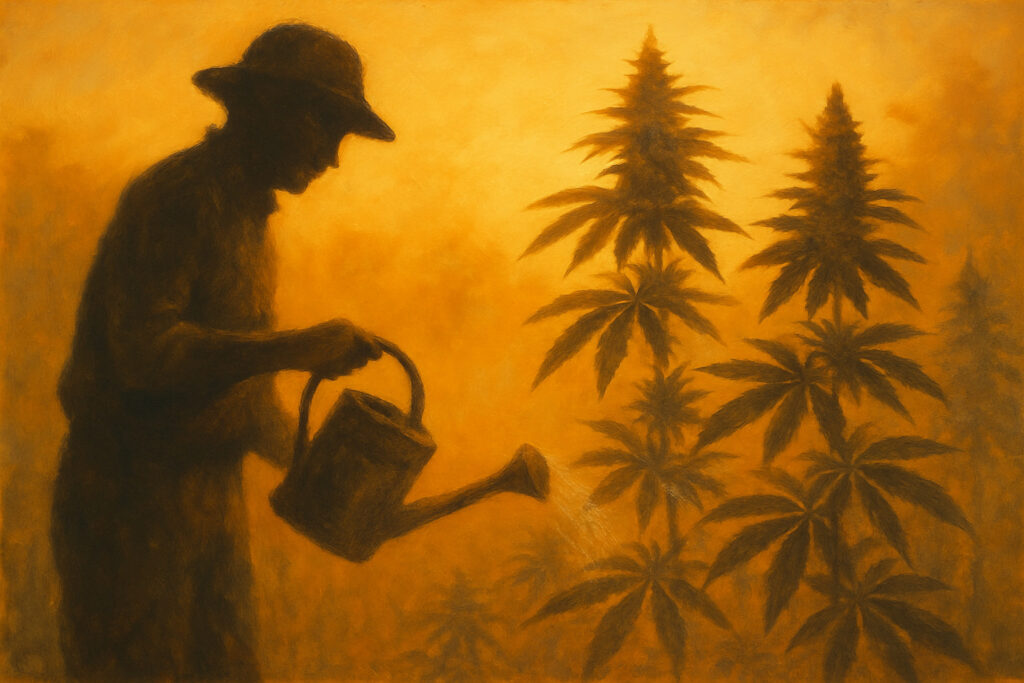
Breathing Your Way Back Home
A Buddhist parable of a blind turtle inspires reflection on life’s rarity, balancing samsara’s struggles with presence and spiritual homecoming.

Every grower starts with enthusiasm, a few good genetics, and the hope that sunlight, water, and love will do the rest. But plants are living systems, not house guests—they speak a language of balance, and most new growers don’t yet know how to listen.
Over the years, I’ve watched hundreds of home cultivators—friends, students, customers—make the same handful of mistakes. These aren’t failures of intention; they’re failures of translation. The plant is communicating; we’re just misreading the signs.
Let’s break down the five most common missteps and how to correct them before they cost you a harvest.
This one’s universal. Overwatering is the most common way new growers kill their plants. Roots need oxygen as much as they need moisture, and a waterlogged medium suffocates the microbiome. When roots drown, pathogens thrive, and growth stalls.
Underwatering, though less frequent, is equally destructive—it leaves the rhizosphere dry, microbial life dormant, and nutrient uptake halted. The plant spends its energy on survival, not growth.
The fix? Learn the rhythm of your medium. Lift your pots. Feel the weight difference between saturated and dry soil. Check the top inch—if it’s still damp, wait. Consistency beats quantity. A wet–dry cycle encourages roots to stretch deeper, strengthens the plant’s immune response, and stabilizes its metabolism.
Remember: you’re not watering the plant; you’re watering the soil. Keep the microbes happy and the plant will follow.
The urge to feed more is one of the most expensive beginner habits. Bottles promise explosive growth and sticky flowers, but the plant doesn’t care about marketing—it cares about balance. Excess salts accumulate in the medium, burning roots and disrupting osmotic flow. The result is classic nutrient lockout: pale leaves, slow growth, brittle stems, and mystery deficiencies that usually aren’t deficiencies at all—they’re just overfeeding in disguise.
Underfeeding, on the other hand, usually comes from fear—growers afraid to “burn” their plants end up starving them during key metabolic phases.
The middle path is precision. Start light, observe response, and increase gradually. Use EC or ppm meters to measure your nutrient solution rather than guessing. Think of feeding as a dialogue: the plant responds, and you adjust.
And here’s the truth: the best feeding regimen isn’t about products—it’s about consistency and clarity. Simpler programs, properly timed, beat complicated ones every time.
Many homegrowers get the big things right—lights, nutrients, soil—but overlook the invisible forces: air movement, humidity, and temperature differential. Yet these are the conditions that dictate how efficiently your plant can breathe, transpire, and photosynthesize.
Good airflow prevents mold, strengthens stems, and keeps CO₂ circulating. Poor airflow invites disease and weak structure.
Vapor Pressure Deficit (VPD)—the balance between temperature and humidity—determines how easily a plant can move water from roots to leaves. When VPD is off, the plant either transpires too fast (wilting) or too slow (stagnation).
You don’t need a degree to manage this. A small hygrometer, a fan, and a VPD chart can change everything. Aim for steady, moderate conditions: around 78°F with 55–65% humidity during veg, tapering humidity down as you move into flower. Stability matters more than perfection. Plants love predictability; chaos stresses them out just like it stresses us.
Light is the fuel of photosynthesis—and like any fuel, too much or too little throws the system out of tune.
Too little light yields lanky plants with wide internodes and small, airy flowers. Too much light—especially with modern LEDs—can bleach leaves, stunt growth, and create photooxidative stress.
Measure PPFD (photosynthetic photon flux density) if you can. For most home setups, 400-600 µmol/m²/s in veg and 900–1100 µmol/m²/s in flower is the sweet spot. If you don’t have a light meter (but you really do need one), watch the leaves: when they pray upward slightly, you’re in the zone; when they claw or bleach, back off.
Light also drives metabolism. Sync your feeding and watering to the photoperiod—plants drink and eat more when light is strong and temperatures are stable.
Remember: the plant’s relationship with light is emotional. Too much intensity feels like interrogation. The goal is radiant energy, not punishment.
The fifth mistake is philosophical as much as practical—not testing your soil or media. You’d never take a blood panel and ignore the results, yet many growers do exactly that with their soil. They plant, they water, and they hope.
But soil is a living ecosystem, and it holds memory. Nutrient imbalances, pH drift, and microbial collapse often start weeks before symptoms appear in the leaves.
A simple soil test (available from most ag labs or university extensions) will tell you the elemental story: calcium, magnesium, phosphorus, potassium, organic matter, and cation exchange capacity. With that information, you’re not guessing—you’re steering.
When you fly blind, you end up reacting. When you test, you can anticipate. That’s the difference between chasing problems and cultivating solutions.
And don’t forget: soil health isn’t just chemistry—it’s biology. Feed the microbes with compost teas, humics, and organic matter. When the soil is alive, it self-corrects. When it’s sterile, you’re just babysitting. A Microbiometer ($200) allows you to test your biology as well. It’s a tool we have used for years now on the farm and it is indispensable.
All five mistakes—watering, feeding, environment, lighting, and soil imbalance—trace back to the same root: inattention to relationship.
Growing is not about control; it’s about communication. When you overwater, overfeed, or over-light, you’re not listening. When you test your soil, check your humidity, and observe your leaves, you’re entering dialogue.
Plants mirror the grower’s state of mind. Impatience shows up as burn or wilt; presence shows up as vigor.
So slow down. Pay attention. Treat your garden like a conversation, not a transaction. The plant will tell you what it needs—if you stop talking long enough to listen.
Let’s Cultivate!

A Buddhist parable of a blind turtle inspires reflection on life’s rarity, balancing samsara’s struggles with presence and spiritual homecoming.

Pablo Neruda’s “Keeping Quiet” teaches stillness amid chaos, reminding us that silence, breath, and presence restore peace and balance.

Inspired by Rory McIlroy’s Masters win and local golf struggles, this meditation explores resilience, nerves, and the courage to persevere.